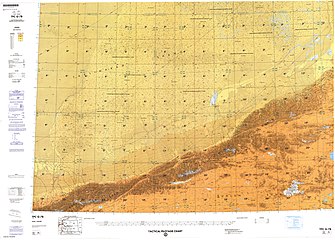Niya County
Niya County
Minfeng | |
|---|---|
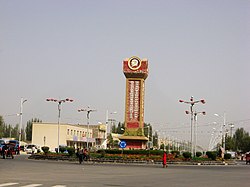 | |
 Niya County (red) in Hotan Prefecture (yellow) and Xinjiang | |
| Coordinates:37°04′N82°46′E/ 37.067°N 82.767°E | |
| Country | China |
| Autonomous region | Xinjiang |
| Prefecture | Hotan |
| County seat | Niya |
| Area | |
| • Total | 56,759.86 km2(21,915.10 sq mi) |
| Population (2020)[3] | |
| • Total | 42,649 |
| • Density | 0.75/km2(1.9/sq mi) |
| Ethnic groups | |
| • Major ethnic groups | Uyghur[4] |
| Time zone | UTC+8(China Standard[a]) |
| Postal code | 848500 |
| Website | www |
| Niya County | |||||||||||
|---|---|---|---|---|---|---|---|---|---|---|---|
| Uyghur name | |||||||||||
| Uyghur | نىيە ناھىيىسى | ||||||||||
| |||||||||||
| Chinese name | |||||||||||
| Simplified Chinese | Dân phongHuyện | ||||||||||
| Traditional Chinese | Dân phongHuyện | ||||||||||
| |||||||||||
| Alternative Chinese name | |||||||||||
| Simplified Chinese | Ni nhã huyện | ||||||||||
| Traditional Chinese | Ni nhã huyện | ||||||||||
| |||||||||||
Niya County[5][6][7](transliterated from the Uyghurنىيە ناھىيىسىNiyă Nahiyisi;Chinese:Ni nhã huyện), also fromMandarin ChineseasMinfeng County(Chinese:Dân phong huyện), is a county within theXinjiang Uyghur Autonomous Regionand is under the administration of theHotan Prefecture.It contains an area of 56,726 km2(21,902 sq mi). According to the 2002 census, it has a population of 30,000.[8]The county is bordered to the north byXayar County,to the east byQiemo/Qarqan County,to the west byYutian / Keriya Countyand to the south byNgari Prefecturein Tibet.
The county seat is in the town ofNiya,which is often referred to by the county name (Minfeng) as well. TheNiya ruinsare located 115 km north of Niya.
History[edit]
In the early 20th century,Aurel Steincarried out several expeditions in the area including exploration of the ancientNiya ruins.
In 1945, MinfengShezhiju(Dân phong thiết trị cục) was established. In 1947, the area became Minfeng County.[2]
In 2012, the township of Yawatongguz (Yawatongguzi) was established.[1][9]
In early 2015, a joint report issued by the Water Conservancy Office of Hotan prefecture and the regional Water Conservancy Department reported that up to 80 percent of the population of the county did not have access to clean drinking water.[10]
In June 2015 in the lead-up toRamadan,a beer festival was held in the county leading to condemnation from Dilxat Raxit, spokesman for theWorld Uyghur Congress.[7]
In September 2015, residents of the county were reported to be subject to new rules concerning unacceptable given names for Uyghur children.[11]
On December 8, 2019, County Communist Party Committee Vice Secretary (Huyện ủy phó thư ký) and County Magistrate (Huyện trường) Ëziz Eli (Ngải tắc tư · ngải lực) penned a criticism of theUyghur Human Rights Policy Act.[12]
Geography[edit]
The northern part of the county is located in theTaklamakan Desertand consists of large areas of sanddunes.The population centers on oases around rivers flowing down from the mountains in the southern part of the county.
Climate[edit]
As of 1997[update],on average, Minfeng experienced blowing dust or sand on 189 days in a year and visibility below 4,800 meters for more than half of winter and summer as well as for thirty to forty percent of spring. The lowest spring time temperature recorded in Minfeng was -22°C.[13]
| Climate data for Niya, elevation 1,410 m (4,630 ft), (1991–2020 normals, extremes 1981–2010) | |||||||||||||
|---|---|---|---|---|---|---|---|---|---|---|---|---|---|
| Month | Jan | Feb | Mar | Apr | May | Jun | Jul | Aug | Sep | Oct | Nov | Dec | Year |
| Record high °C (°F) | 19.2 (66.6) |
22.3 (72.1) |
33.2 (91.8) |
36.1 (97.0) |
37.7 (99.9) |
40.8 (105.4) |
41.8 (107.2) |
41.7 (107.1) |
37.8 (100.0) |
32.3 (90.1) |
25.7 (78.3) |
21.5 (70.7) |
41.8 (107.2) |
| Mean daily maximum °C (°F) | 1.7 (35.1) |
7.8 (46.0) |
17.2 (63.0) |
24.6 (76.3) |
28.7 (83.7) |
31.8 (89.2) |
33.5 (92.3) |
32.6 (90.7) |
28.4 (83.1) |
21.6 (70.9) |
12.5 (54.5) |
3.8 (38.8) |
20.4 (68.6) |
| Daily mean °C (°F) | −5.2 (22.6) |
0.6 (33.1) |
9.3 (48.7) |
16.5 (61.7) |
20.9 (69.6) |
24.4 (75.9) |
25.9 (78.6) |
24.8 (76.6) |
19.8 (67.6) |
11.7 (53.1) |
3.8 (38.8) |
−3.3 (26.1) |
12.4 (54.4) |
| Mean daily minimum °C (°F) | −11.1 (12.0) |
−6.0 (21.2) |
1.6 (34.9) |
8.5 (47.3) |
13.3 (55.9) |
17.4 (63.3) |
19.1 (66.4) |
17.7 (63.9) |
12.0 (53.6) |
3.2 (37.8) |
−3.2 (26.2) |
−8.9 (16.0) |
5.3 (41.5) |
| Record low °C (°F) | −25.8 (−14.4) |
−23.7 (−10.7) |
−11.4 (11.5) |
−2.7 (27.1) |
0.7 (33.3) |
6.9 (44.4) |
11.1 (52.0) |
6.2 (43.2) |
1.4 (34.5) |
−6.6 (20.1) |
−12.8 (9.0) |
−19.8 (−3.6) |
−25.8 (−14.4) |
| Averageprecipitationmm (inches) | 1.8 (0.07) |
1.1 (0.04) |
1.1 (0.04) |
2.9 (0.11) |
5.3 (0.21) |
14.6 (0.57) |
9.6 (0.38) |
6.0 (0.24) |
4.8 (0.19) |
0.4 (0.02) |
0.2 (0.01) |
1.0 (0.04) |
48.8 (1.92) |
| Average precipitation days(≥ 0.1 mm) | 2.3 | 1.1 | 0.6 | 0.8 | 2.0 | 4.4 | 3.8 | 2.1 | 1.3 | 0.3 | 0.3 | 1.4 | 20.4 |
| Average snowy days | 4.9 | 2.1 | 0.6 | 0.2 | 0 | 0 | 0 | 0 | 0 | 0 | 0.5 | 2.8 | 11.1 |
| Averagerelative humidity(%) | 52 | 42 | 28 | 26 | 31 | 37 | 41 | 42 | 43 | 43 | 43 | 53 | 40 |
| Mean monthlysunshine hours | 206.4 | 204.2 | 235.6 | 251.2 | 273.6 | 254.4 | 244.3 | 244.1 | 257.1 | 283.6 | 236.3 | 211.8 | 2,902.6 |
| Percentpossible sunshine | 67 | 66 | 63 | 63 | 62 | 58 | 55 | 59 | 70 | 83 | 79 | 71 | 66 |
| Source:China Meteorological Administration[14][15] | |||||||||||||
Administrative divisions[edit]
The county includes onetownand sixtownships:[1][16][17]
| Name | Simplified Chinese | Hanyu Pinyin | Uyghur(UEY) | Uyghur Latin (ULY) | Administrative division code | Notes | |
|---|---|---|---|---|---|---|---|
| Town | |||||||
| Niya Town | Ni nhã trấn | Níyǎ Zhèn | نىيە بازىرى | niye baziri | 653227100 | ||
| Township | |||||||
| Niya Township | Ni nhã hương | Níyǎ Xiāng | نىيە يېزىسى | niye yëzisi | 653227200 | ||
| Rokiya Township | Nhược khắc nhã hương | Ruòkèyǎ Xiāng | رۇكىيا يېزىسى | rukiya yëzisi | 653227201 | ||
| Salgozak Township | Tát lặc ngô tắc khắc hương | Sàlèwúzékè Xiāng | سالغوزەك يېزىسى[18] | salghozek yëzisi | 653227202 | ||
| Yeyik Township | Diệp diệc khắc hương | Yèyìkè Xiāng | يېيىق يېزىسى | yëyiq yëzisi | 653227203 | ||
| Andir Township | An địch nhĩ hương | Āndí'ěr Xiāng | ئەندىر يېزىسى[19] | Endir yëzisi | 653227204 | ||
| Yawatongguz Township (area of Yawatongguzlangar[20]) |
Á ngõa thông cổ tư hương | Yàwǎtōnggǔzī Xiāng | ياۋا توڭگۇز يېزىسى | yawatongguz yëzisi | 653227205 | ||
Economy[edit]
The economy is primarily based on agriculture and livestock farming. Products of the county include corn, wheat, cotton and sheep wool. Industries in the county include electronics, agriculture technology, food processing, carpets and construction.[2]
Demographics[edit]
As of 2015, Out of the 38,492 residents, 34,900 of the county wereUyghur,3,509 wereHan Chineseand 83 were from other ethnic groups.[21]
As of 1999, 90.94% of the population of Niya (Minfeng) County was Uyghur and 8.91% of the population was Han Chinese.[22]
Transportation[edit]
- China National Highway 315
- Tarim Desert Highway
- Minfeng railway station servingHotan–Ruoqiang railway
Gallery[edit]
-
New Mosque -Minfeng.
-
Niya men (1912)
-
Map including Minfeng (labeled as MIN-FENG (NIYA BAZAR)) and surrounding region in theInternational Map of the World(ATC,1971)
-
Map including Niya (labeled as MIN-FENG (NI-YA)) (ATC,1971)
-
Map including the southern part of Minfeng/Niya County and the county's border with Tibet (DMA,1975)
-
Map including part of Niya (Minfeng) County (DMA,1979)
-
Map including Niya (labeled as Minfeng) (DMA, 1990)
Notes[edit]
- ^Locals in Xinjiang frequently observeUTC+6(Xinjiang Time), 2 hours behind Beijing.
- ^From map: "The representation of international boundaries is not necessarily authoritative."
References[edit]
- ^abcDân phong huyện lịch sử duyên cách[Minfeng County Historical Development] (in Simplified Chinese). XZQH.org. 2 December 2014.Retrieved8 December2019.
2003 niên, dân phong huyện tổng diện tích 56759.86 bình phương thiên mễ, {...}2010 niên đệ lục thứ nhân khẩu phổ tra, dân phong huyện thường trụ tổng nhân khẩu 33932 nhân, kỳ trung: Ni nhã trấn 3486 nhân, ni nhã hương 6373 nhân, nhược khắc nhã hương 6895 nhân, tát lặc ngô tắc khắc hương 4195 nhân, diệp diệc khắc hương 3751 nhân, an địch nhĩ hương 343 nhân, an địch nhĩ mục tràng 2165 nhân, thành trấn nhai đạo 6724 nhân. 2012 niên, thiết lập á ngõa thông cổ tư hương, hương chính phủ trú á ngõa thông cổ tư thôn ( tân chính hàm [2012]90 hào ). Điều chỉnh hậu, toàn huyện hạt 1 cá trấn, 6 cá hương: Ni nhã trấn, ni nhã hương, nhược khắc nhã hương, tát lặc ngô tắc khắc hương, diệp diệc khắc hương, an địch nhĩ hương, á ngõa thông cổ tư hương.
- ^abcHạ chinh nông; trần chí lập, eds. (September 2009).Từ hải: Đệ lục bản thải đồ bổn[Cihai(Sixth Edition in Color)] (in Chinese). Thượng hải.Shanghai:Thượng hải từ thư xuất bản xã.Shanghai Lexicographical Publishing House.p. 1580.ISBN9787532628599.
Diện tích 5.67 vạn bình phương thiên mễ. {...}1945 niên do hòa điền huyện ( kim hòa điền huyện ) tích trí dân phong thiết trị cục, 1947 niên cải dân phong huyện. Kinh tế dĩ nông, mục nghiệp vi chủ, sản ngọc mễ, tiểu mạch, miên hoa hòa dương mao. Công nghiệp hữu điện lực, nông cơ tu tạo, thực phẩm gia công, địa thảm, kiến tài đẳng.
- ^Xinjiang: Prefectures, Cities, Districts and Counties
- ^1997 niên dân phong huyện hành chính khu hoa.XZQH.org(in Simplified Chinese). 6 January 2011.Retrieved24 March2020.
Kỳ trung duy ngô nhĩ tộc chiêm 91%, hạt 1 trấn, 5 hương.
- ^Ministry of Housing and Urban-Rural Development(2010).Kiến trúc kháng chấn thiết kế quy phạm[GB50011-2010: Code for Seismic Design of Buildings] (in English and Simplified Chinese).Beijing:China Architecture & Building Press. p.203– viaGoogle Books.
Niya County
- ^"'Many Uygurs like to drink': Chinese academic defends beer festival in Muslim region ".South China Morning Post.24 June 2015.Retrieved24 March2020.
Xinjiang's government-run Tianshan website showed that officials in Niya county organised an event where local Muslims made and ate rice dumplings on Saturday, three days after the start of Ramadan, during which devout Muslims abstain from all food and drink during daylight hours.
- ^abBen Blanchard (22 June 2015). Paul Tait (ed.)."Exiles angered as China holds beer festival in Muslim county".Reuters.Retrieved9 December2019.
The beer festival happened in a village in Niya County in the deep south of Xinjiang, which is overwhelmingly populated by the Muslim Uighur people who call Xinjiang home. Muslims are not meant to consume alcohol, according to the Koran. The Niya government website said the "beer competition", which happened last Monday just before the start of Ramadan, was attended by more than 60 young farmers and herders.
- ^The Silk Road - China and the Karakorum Highway: A Travel Companion 1780763565 Jonathan Tucker - 2015 - Niya, north of Minfeng, Xinjiang province (photograph by Antonia Tozer) Wooden tablet written in Kharosthi (Spink and Son Ltd.) The Shanpula cemetery, Luopu county, near Khotan, Xinjiang province (photograph by Antonia Tozer) Remains.
- ^2012 niên thống kế dụng khu hoa đại mã hòa thành hương hoa phân đại mã: Dân phong huyện[2012 Statistical Area Numbers and Rural-Urban Area Numbers: Minfeng County] (in Simplified Chinese).National Bureau of Statistics of the People's Republic of China.2012.Retrieved14 January2020.
Đại mã danh xưng 653227100000 ni nhã trấn 653227200000 ni nhã hương 653227201000 nhược khắc nhã hương 653227202000 tát lặc ngô tắc khắc hương 653227203000 diệp diệc khắc hương 653227204000 á ngõa thông cổ tư hương 653227205000 an địch nhĩ hương
- ^Joshua Lipes; reporter Jilil Kashgary (4 February 2015)."More Than One Million Lack Clean Water in Xinjiang's Hotan Prefecture".Radio Free Asia.Translated by Mamatjan Juma.Retrieved11 December2019.
- ^Roseanne Gerin; reporter Eset Sulaiman (24 September 2015). Eset Sulaiman (ed.)."Chinese Authorities Ban Muslim Names Among Uyghurs in Hotan".Retrieved11 December2019.
A Uyghur woman named Turakhan who lives in a suburban village of Niya (in Chinese, Minfeng) county in Hotan (Hetian) prefecture told RFA's Uyghur Service on Wednesday that the village chief and police had informed all residents about "the list of forbidden Muslim names." "My daughter's name is Muslime, so the village police came to our house and told us that we must change our daughter's name as soon as possible," she said. "The police explained to us that a name such as Muslime was officially forbidden. Under such circumstances, we were forced to change our daughter's name." The police also told Turakhan: "It is the decision of the township and village authorities. Don't ask any foolish questions." Turakhan later found out that authorities were forbidding children whose parents did not change their names from attending kindergarten and elementary school, she said.
- ^Ngải tắc tư · ngải lực (8 December 2019). Lý mộng đình (ed.).Kiên quyết bất duẫn hứa mỹ quốc súc ý để hủy hòa mạt hắc tân cương đích nhân quyền trạng huống.Xinhua News Agency(in Simplified Chinese).Retrieved8 December2019.
- ^MSgt Donald E. Carey; Melody L. Higdon; Robert S. Lilianstrom; MSgt Charles D. Surls (September 1997)."East Asia A Climatological Study".Air Force Combat Climatology Center. pp. 4–7, 4–11, 4–29, 4–44 – viaInternet Archive.
- ^Trung quốc khí tượng sổ cư võng – WeatherBk Data(in Simplified Chinese).China Meteorological Administration.Retrieved10 October2023.
- ^ "Experience Template"Trung quốc khí tượng sổ cư võng(in Simplified Chinese).China Meteorological Administration.Retrieved10 October2023.
- ^2018 niên thống kế dụng khu hoa đại mã hòa thành hương hoa phân đại mã: Dân phong huyện[2018 Statistical Area Numbers and Rural-Urban Area Numbers: Minfeng County] (in Simplified Chinese).National Bureau of Statistics of the People's Republic of China.2018.Retrieved8 December2019.
Thống kế dụng khu hoa đại mã danh xưng 653227100000 ni nhã trấn 653227200000 ni nhã hương 653227201000 nhược khắc nhã hương 653227202000 tát lặc ngô tắc khắc hương 653227203000 diệp diệc khắc hương 653227204000 an địch nhĩ hương 653227205000 á ngõa thông cổ tư hương
- ^Thủ hiệt.Ni nhã võng - dân phong huyện chính phủ môn hộ võng trạm(in Simplified Chinese). Archived fromthe originalon 23 April 2018.Retrieved19 April2020.
Hương trấn ni nhã hương ni nhã trấn nhược khắc nhã hương diệp diệc khắc hương tát lặc ngô tắc khắc hương á ngõa thông cổ tư hương an địch nhĩ hương nhai đạo bạn sự xử
- ^سالغوزەك (Variant Non-Roman Script - VS)atGEOnet Names Server,United States National Geospatial-Intelligence Agency
- ^ئابدۇسالام ئابلىز,ed. (24 December 2019).پەن - تېخنىكا ئارقىلىق نامراتلارنى دەل جايىدا يۆلەش كەنت ئاھالىلىرىنىڭ كىرىمىنى ئاشۇرۇپ بېيىتتى.A khắc tô tân văn võng - duy văn bản(in Uyghur).Retrieved13 May2020.
نىيە ناھىيەسى ئەندىر يېزىسى
- ^Webster's 21st Century World Atlas.Barnes & Noble Books.1999. p. 83 – viaInternet Archive.
Yawatongguzlangar{...}Yeyik
- ^3-7 các địa, châu, thị, huyện ( thị ) phân dân tộc nhân khẩu sổ(in Simplified Chinese).شىنجاڭ ئۇيغۇر ئاپتونوم رايونىTân cương duy ngô nhĩ tự trị khu thống kế cụcStatistic Bureau of Xinjiang Uygur Autonomous Region. 15 March 2017.Archivedfrom the original on 11 October 2017.Retrieved3 September2017.
- ^Morris Rossabi,ed. (2004).Governing China's Multiethnic Frontiers(PDF).University of Washington Press.p. 180.ISBN0-295-98390-6.

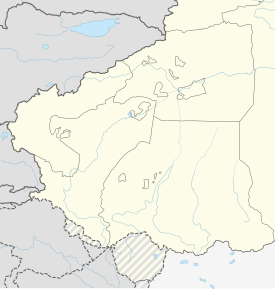
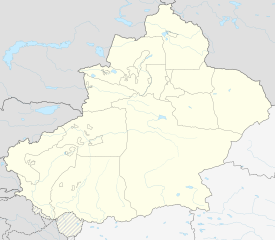
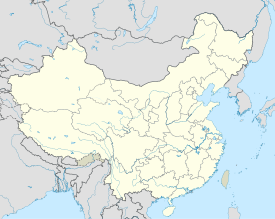


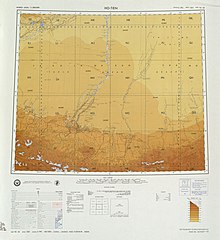



![Map including Minfeng (labeled as Minfeng (Min-feng)) and surrounding region (DMA, 1980)[b]](https://upload.wikimedia.org/wikipedia/commons/thumb/f/fb/Operational_Navigation_Chart_G-7%2C_6th_edition.jpg/331px-Operational_Navigation_Chart_G-7%2C_6th_edition.jpg)
